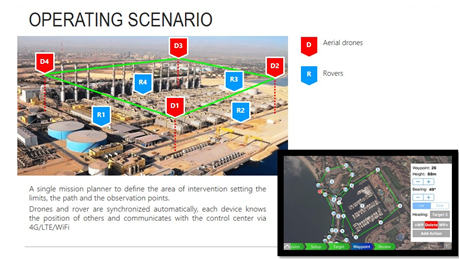| In CPSwarm we will consider heterogeneous swarms of ground robots/rovers and UAVs to conduct certain missions in the surveillance of critical infrastructure like, e.g., industrial or power plants as well as in Search And Rescue (SAR) tasks. For surveillance, we envision applications of swarms for: a) intrusion detection (detection of unauthorized persons entering the plant area) or b) follow and observe actions of unauthorized persons in the plant. |
| Apart from that in SAR tasks swarms can be exploited for: a) generating a situation overview of the disaster scene in case of an industrial plant accident including real-time images (VIS, IR), toxic and explosive gas leakage detection or b) finding of human casualties or persons trapped in the disaster area. The gathered information is used to help security personnel, first responders as well as rescue teams to conduct their mission efficiently. |

|
| The two application scenarios share common requirements: a vast spatial area has to be inspected and information has to be provided to the stakeholders (security personnel, rescue teams, etc.) in real-time, especially in case of an incident. Swarms can reduce the inspection/detection times compared to, e.g., single UAV/rover applications. Especially in SAR a single minute can decide between death and life. The inspection cycle time for surveillance can be reduced considerably enabling denser inspection. At the core, there are multiple UAVs and multiple rovers that can act autonomously. They carry different sensors (VIS or IR cameras, microphones, gas sensors, etc.). Either each vehicle carries all sensor modalities or the sensor modalities are distributed among the vehicles. The vehicles carry intelligence and can communicate among each other (via WiFi, 4G or others). They operate as a self-organizing mixed team where particular tasks for each vehicle are not predefined at mission start but negotiated during mission execution. Such a swarm is highly adaptive to changes in the environment and can act dynamically. |
| For example a ground robot may order a camera UAV to look for the best path, or a UAV finds something strange and orders UAVs with other sensors to check or asks if one of the rovers can move there to perform some action. |
| Moreover, in contrast to fully centralized control, such a swarm can still operate even if the connectivity among vehicles or with a base station is sparse. The swarm mission itself is defined in a central operation center in the beginning of the mission with a dedicated swarm definition tool (mission planner) that defines the goals and behavior of the swarm, thanks to the CPSwarm Deployment Toolchain. |
| The central station can additionally collect the sensor data and perform sensor fusion and analysis in real time. The vehicles can also form a meshed ad-hoc communication network to improve communication performance. The central station is equipped with suitable user interfaces to enable the operator to influence the swarm (e.g. tell that he wants to see a certain scene then the swarm automatically sends the closest vehicle to the scene, camera remote control) or to document the swarm mission including all GPS and sensor data. On top of this, members of intervention teams may access the swarm and its data directly via wearable devices and, possibly influence/modify the swarm tasks. A possible test setting may be a mixed swarm of 4 UAVs and 4 rovers. They may be sent out to map a (disaster) area, look for casualties or perform intrusion detection with automated tracking of the intruder. |

 Copyright © 2018 — cpswarm.eu.
Copyright © 2018 — cpswarm.eu.